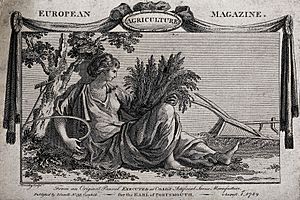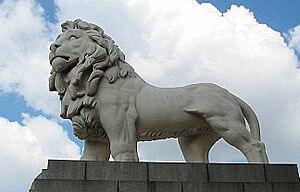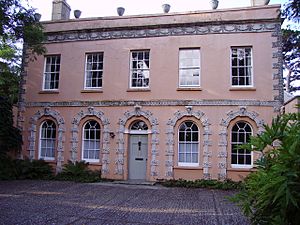Eleanor Coade facts for kids
Quick facts for kids
Eleanor Coade
|
|
|---|---|
| Born | 3 June 1733 Exeter, Devon, England
|
| Died | 18 November 1821 (aged 88) Camberwell, London, England
|
| Resting place | Bunhill Fields cemetery, London |
| Occupation | Business woman, neoclassical statuary sculptor and manufacturer |
Eleanor Coade (born June 3, 1733 – died November 18, 1821) was a clever British businesswoman. She was famous for making beautiful statues and decorations. These items were made from a special material called Lithodipyra, or Coade stone. She ran her business for over 50 years, from 1769 until she passed away.
Coade stone was a very strong, long-lasting, and weather-resistant material. It was made from a special type of ceramic stoneware. Even today, many statues and decorations made from Coade stone look almost new! Eleanor Coade didn't invent "artificial stone." Others had tried before, but she made the best recipe and firing process.
She was great at making high-quality products and had excellent artistic taste. She was also very good at business and marketing. This helped her create the most successful stone products of her time. Her company made stoneware for famous places like St George's Chapel, Windsor, The Royal Pavilion, Brighton, and Buckingham Palace.
Eleanor was born in Exeter to families who were wool merchants. She ran her company in Lambeth, London. Her business had different names over the years, including "Coade's Artificial Stone Manufactory" and "Coade and Sealy." She even received a special honor from King George III. Eleanor was a very religious Baptist and never married. She passed away in Camberwell, London.
In 1784, her uncle gave her Belmont House. This was a holiday home in Lyme Regis, her father's hometown. She decorated the house with lots of her special Coade stone.
Contents
Eleanor's Life Story
Growing Up in Exeter
Eleanor Coade was born on June 3, 1733, in Exeter. Her parents, George and Eleanor Coade, were devout Baptists. Her father, George, was a wool merchant from Lyme Regis. Her mother, Eleanor, came from a family of merchants and textile makers in Tiverton, Devon. Eleanor also had a younger sister named Elizabeth, born in 1738.
Eleanor's grandmother, Sarah Enchmarch, was a very successful businesswoman. She ran her family's textile business in Tiverton for 25 years after her husband died. Tiverton was a big center for wool, with thousands of workers. Mrs. Enchmarch employed 200 people to make cloth. She was known for being very smart and even used spies to learn new techniques! She rebuilt her family's large home in 1749 using money from her business.
Moving to London
Around 1760, Eleanor's family moved from Exeter to London. Her father, George Coade, had faced financial difficulties. By the mid-1760s, Eleanor Coade had started her own business. She worked as a linen draper in London. At that time, it was common for unmarried businesswomen to use "Mrs." as a polite title.
In early 1769, her father died after facing financial problems again. Around the same time, Eleanor Coade bought an artificial stone factory. She then lived at the factory in Lambeth. Records show that she was directly managing the factory by 1771.
In 1784, Eleanor received Belmont House in Lyme Regis from her uncle. It was a simple two-story house built in 1774. The famous author John Fowles lived there later. Today, it is owned by the Landmark Trust.
Later in her life, Eleanor lived in different parts of London. When she died in 1821, she was living in Camberwell.
Exhibiting Artworks
Eleanor Coade's company displayed its sculptures at the Society of Artists of Great Britain. This happened between 1773 and 1780. While she was listed as a sculptor, it's thought that her company produced the works. She likely oversaw the creation rather than sculpting them herself.
Her company exhibited many different types of pieces. These included figures like Urania and Flora. They also showed decorative items like chimneypieces and vases. Other exhibits included statues for candelabrums and figures of animals like lions. These exhibitions helped show off the amazing quality of Coade stone.
Eleanor's Final Years
Eleanor Coade was a very religious Baptist. She never married and passed away on November 18, 1821. Her death was noted in The Gentleman's Magazine. This publication praised her as the "sole inventor and proprietor of an art which deserves considerable notice." It highlighted the great qualities of Coade Stone.
In her will, Eleanor left much of her money to charity schools and religious leaders. She also left money to her family. Eleanor believed in women's rights. She made sure that money left to her married women friends was theirs alone. Their husbands could not control these funds.
Eleanor is buried in an unmarked grave at Bunhill Fields cemetery in London. This cemetery was often used by Nonconformists.
Today, a special Coade Stone marks her memory. It is located under Westminster Bridge, near the Royal Festival Hall. This is where her factory used to be. The stone is part of a large wheel used in her factory.
Her Amazing Stone Business

In late 1769, when she was 36, Eleanor Coade bought a struggling business. It made artificial stone and was located in Lambeth. She took charge and turned it into "Coade's Artificial Stone Manufactory." Within two years, she fired the previous owner. Her special ceramic stoneware was then sold as "Coade's Lithodipyra" for the next 50 years.
Eleanor's business was the only one of its kind to truly succeed. She made products from ceramic that looked like real stone. These items were incredibly strong and lasted a very long time.
John Bacon, a talented sculptor, joined Mrs. Coade's team in 1769. In 1771, she made him the works supervisor. He led the design and model-making until he died in 1799. Their teamwork led to great success. The Coade Artificial Stone Manufactory worked with many famous architects. These included Robert Adam, James Wyatt, and John Nash. Mrs. Coade also hired other skilled designers and modelers.
After 1780, King George III asked Coade to create a Gothic screen for St George's Chapel, Windsor Castle.
In 1784, she created a detailed catalogue of 746 designs. This included statues, busts, friezes, and chimneypieces. Since the ceramic moulds could be used many times, production was very efficient. Some moulds lasted over 50 years!
In 1799, Mrs. Coade brought her cousin, John Sealy, into the business. The company was then called "Coade and Sealy." After he died in 1813, it went back to being just "Coade." She also opened a showroom called Coade's Gallery. This was near Westminster Bridge to show off her products.
In 1813, William Croggon became the new manager. He was a sculptor and a distant cousin. Croggon managed the factory until Eleanor's death. He then bought the company from her estate. The business continued to do well for some time. However, Croggon faced financial trouble in 1833. This was due to changing tastes and unpaid debts.
How Eleanor Succeeded
Eleanor Coade's success as a businesswoman was very rare in her time. She worked incredibly hard and focused on making high-quality products every time. She was the only person to truly succeed in the artificial stone business. This was because she had great management skills. She also had a talent for business and for promoting her products.
She carefully watched over how the clay mixtures were made. She also supervised the firing process for all her products. She quickly fired the previous owner of the business when he wasn't doing well. She also advertised her business in newspapers.
Eleanor built strong relationships with respected architects and designers. This was important because she could make many copies of their designs. Even Josiah Wedgwood, another famous pottery maker, struggled to get architects to support his products. This shows how successful Eleanor Coade was!
Famous Coade Stone Creations

Eleanor's factory made large ceramic statues and many types of decorative architectural features. These items were incredibly strong. They could even resist the polluted air of London, which was full of smoke from coal.
Some famous Coade stone works include:
- The front of the original Twinings tea shop on the Strand.
- Decorations at the back of Buckingham Palace.
- The large lion statue on Westminster Bridge.
- The Nelson Pediment at the Royal Naval College, Greenwich. This mural was considered the best work by Coade's team.
- The statue of George III on the seafront in Weymouth, Dorset.
- The stone awning and statues at Schomberg House in Pall Mall, London.
- The crest on the Imperial War Museum.
- Plaques at Hammerwood Park near East Grinstead.


